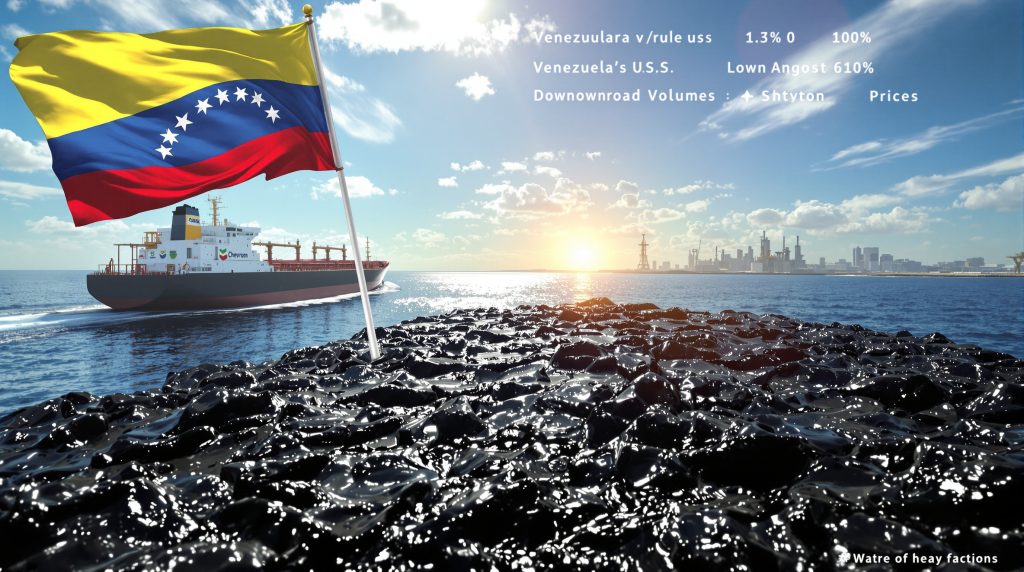Why is Venezuelan Oil Flowing to the U.S. Again?
The resumption of Venezuelan crude oil on its way to the US marks a significant shift in bilateral energy relations after years of sanctions and restricted trade. This development follows careful diplomatic negotiations between Washington and Caracas, creating a pathway for Venezuelan oil tankers to once again deliver their cargo to U.S. refineries.
In late 2022, the Biden administration issued temporary licenses to Chevron, allowing the company to resume limited oil operations in Venezuela. This calculated diplomatic approach aimed to address multiple objectives, including diversifying U.S. energy sources following global supply disruptions caused by the Russia-Ukraine conflict.
According to industry analysts, this policy shift represents a pragmatic recognition of market realities rather than a complete normalization of relations. The Treasury Department's Office of Foreign Assets Control (OFAC) issued specific licenses with strict conditions, allowing only certain transactions while maintaining broader sanctions on Venezuela's government and state oil company PDVSA.
The Policy Shift Behind the Resumption
The policy adjustment enabling Venezuelan crude imports involves a complex framework of temporary licenses rather than a wholesale lifting of sanctions. These licenses permit specific companies to engage in otherwise prohibited transactions with PDVSA, Venezuela's state oil company.
The Biden administration has characterized this approach as "sanctions relief in exchange for democratic progress," linking continued energy trade to specific political and humanitarian benchmarks. This calibrated strategy attempts to balance energy security considerations with broader foreign policy objectives regarding Venezuela's governance.
The temporary licenses require regular renewal, creating a mechanism for ongoing diplomatic leverage while allowing limited economic engagement. This approach differs significantly from the comprehensive sanctions strategy of previous years, reflecting a more nuanced diplomatic posture.
Key Companies Leading the Return
Chevron has emerged as the primary player in this renewed trade relationship, leveraging its long-standing presence in Venezuela that dates back nearly a century. The company received the first OFAC license to resume limited operations in Venezuela and quickly mobilized to restart production at joint ventures with PDVSA.
Industry reports indicate Chevron has chartered multiple tankers specifically for Venezuelan crude transport, including the Kerala vessel that delivered approximately 500,000 barrels of Venezuelan heavy crude to Chevron's Pascagoula, Mississippi refinery in January 2023—the first such delivery in four years.
Chevron's quick mobilization underscores its strategic positioning in Venezuela's oil sector, where it maintains minority stakes in four joint ventures with PDVSA that produced about 200,000 barrels per day before sanctions were imposed. This established infrastructure has allowed the company to capitalize rapidly on policy changes and establish an early-mover advantage.
What Makes Venezuelan Crude Valuable to U.S. Refiners?
Venezuelan crude oil possesses distinct characteristics that make it particularly valuable to certain U.S. refineries, especially those along the Gulf Coast that were specifically designed to process heavier crude varieties. This natural synergy between Venezuelan production and U.S. refining capabilities has historically benefited both countries.
The most significant Venezuelan crude stream, Merey blend, typically has an API gravity of 16°-18° (where lower numbers indicate heavier oil) and sulfur content of approximately 2.5%. This makes it substantially heavier and more sulfuric than benchmark crudes like WTI or Brent, requiring specialized refining equipment to process effectively.
U.S. Gulf Coast refineries invested billions of dollars in complex processing units specifically designed to handle these heavy, high-sulfur crudes during the 1990s and 2000s when Venezuelan imports routinely exceeded 1 million barrels per day. These investments created a natural market fit that persists despite the years-long import disruption.
The Technical Advantages of Heavy Crude
The heavy, high-sulfur nature of Venezuelan crude makes it ideal for complex refineries equipped with specialized processing units including cokers, hydrocrackers, and desulfurization equipment. These facilities can transform the heavy crude into high-value products including ultra-low sulfur diesel, jet fuel, and various petrochemical feedstocks.
When processed in these specialized facilities, Venezuelan heavy crude often yields a higher percentage of middle distillates (including diesel and jet fuel) than lighter varieties. This production profile aligns well with U.S. demand patterns, particularly in the transportation sector.
Additionally, the high metal content (particularly vanadium and nickel) in Venezuelan crude, while presenting processing challenges, provides refiners with recoverable byproducts that have industrial applications, creating additional value streams beyond traditional fuel products.
Price Advantages in the Current Market
In today's market environment, Venezuelan crude typically trades at a substantial discount compared to lighter varieties, often $5-15 per barrel below benchmark prices, providing potential margin benefits for refiners. This pricing dynamic makes Venezuelan imports particularly attractive to U.S. refiners seeking to optimize their input costs.
The discount reflects both quality differentials (heavier, higher-sulfur crudes generally command lower prices) and the ongoing operational and political risks associated with Venezuelan supply. For properly equipped refineries, this price spread creates opportunities for enhanced margins through the procurement of discounted feedstock.
Market analysis indicates that refiners processing Venezuelan crude can potentially realize $2-4 per barrel in additional margin compared to lighter alternatives, depending on current product price spreads and specific refinery configurations. This economic incentive drives continued interest in Venezuelan imports despite the logistical and regulatory complexities involved.
How Does This Impact Global Oil Market Dynamics?
The reintroduction of Venezuelan crude to U.S. markets creates ripple effects throughout the global oil trade landscape, influencing pricing, trade flows, and competitive positioning among various producers and consumers.
While current volumes remain modest compared to global production of approximately 100 million barrels per day, the symbolic significance of Venezuelan oil's return and its potential for future expansion influences market psychology and trade war impact on oil markets beyond the immediate physical impact.
The reentry of Venezuelan barrels into legitimate global trade channels could eventually add several hundred thousand barrels per day of heavy sour crude to the market, a meaningful quantity in the specific segment of heavy oil where alternatives are limited.
Displacement Effects on Other Suppliers
As Venezuelan crude returns to U.S. refineries, it potentially displaces volumes from alternative sources, including Canadian heavy crude (Western Canadian Select), Mexican Maya grade, and certain Middle Eastern varieties like Iraq's Basrah Heavy.
Canadian producers face the most direct competition, as their heavy crude grades serve many of the same U.S. Gulf Coast refineries now receiving Venezuelan barrels. Pipeline constraints have already created pricing challenges for Canadian producers, and the return of Venezuelan supply creates additional competitive pressure.
According to energy economists, each 100,000 barrels per day of Venezuelan crude entering the U.S. market potentially displaces an approximately equivalent volume of alternative heavy crude, forcing those barrels to find new customers, often at discounted prices. This displacement triggers cascading readjustments in global trade flows as suppliers reposition their marketing strategies.
Implications for Global Pricing Benchmarks
The addition of Venezuelan supply to global markets could exert modest downward pressure on heavy crude benchmarks, particularly affecting price differentials between heavy and light grades.
The heavy sour crude market has faced tightness in recent years due to OPEC production impact, Venezuelan sanctions, and Mexican production declines. The return of Venezuelan barrels helps alleviate this specific supply constraint, potentially narrowing quality spreads between heavy and light grades.
For Gulf Coast pricing specifically, the Mars crude benchmark (a medium-heavy U.S. Gulf grade) and Mexican Maya crude differentials serve as key indicators of the market impact, with spread compression often signaling increased heavy crude availability in the region.
What Challenges Does Venezuelan Oil Face in the U.S. Market?
Despite the resumption of shipments, Venezuelan crude faces several significant hurdles in fully reestablishing its position in the U.S. energy landscape. These challenges span technical, financial, and regulatory domains, creating substantial uncertainty about the long-term sustainability of this trade relationship.
The most immediate limitation is Venezuela's severely diminished production capacity, which constrains export potential regardless of market demand or regulatory permissions. Additional complexities arise from ongoing sanctions, financial restrictions, and the general operational difficulties of conducting business in Venezuela's challenging economic environment.
These constraints collectively suggest that while Venezuelan crude has returned to U.S. markets, the volumes will likely remain well below historical levels for the foreseeable future unless significant changes occur in both Venezuela's internal situation and the international regulatory environment.
Infrastructure and Production Constraints
Years of underinvestment and technical deterioration have severely impacted Venezuela's oil infrastructure. Production capacity has declined dramatically from historical peaks, with current output hovering around 900,000 barrels per day compared to previous highs exceeding 3 million barrels daily.
This production decline stems from multiple factors, including:
- Deteriorating reservoir conditions in aging fields
- Lack of maintenance on critical infrastructure
- Shortage of parts and specialized equipment
- Loss of technical personnel through emigration
- Limited access to international investment and expertise
- Electricity supply disruptions affecting pumping operations
Field assessments indicate that many Venezuelan oil facilities operate far below designed capacity, with some fields experiencing production declines of 20-25% annually without intervention drilling. Oil service experts estimate that stabilizing production would require at least $5 billion in immediate investment, with full rehabilitation demanding many times that amount over several years.
Regulatory and Political Uncertainties
The current arrangement allowing Venezuelan crude imports operates under specific license conditions that could change with shifting political priorities or assessments of Venezuela's domestic situation.
The licenses require periodic renewal, creating inherent uncertainty about long-term trade viability. Additionally, the licenses contain provisions linking continued authorization to progress on Venezuelan political negotiations and humanitarian conditions, making them vulnerable to developments outside the energy sector.
This regulatory uncertainty creates challenges for long-term planning and investment decisions for both Venezuelan producers and U.S. refiners engaged in this trade. Companies must navigate complex compliance requirements and maintain contingency plans for potential policy shifts, adding operational complexity and cost.
How Does This Fit Into Broader U.S. Energy Security Strategy?
The resumption of Venezuelan crude imports represents one component of a multifaceted approach to U.S. energy security that balances domestic production, diverse import sources, and strategic reserves.
While U.S. oil production has grown substantially over the past decade, reaching approximately 13 million barrels per day, the country continues to import specific crude varieties that align with its refining infrastructure. Venezuelan heavy crude fills a particular niche in this consumption pattern, complementing rather than competing with domestic light crude production.
The strategic value of Venezuelan imports extends beyond simple volume considerations to include geopolitical factors, hemispheric relations, and the operational flexibility that diverse supply sources provide to the U.S. energy system.
Diversification of Heavy Crude Sources
By reintroducing Venezuelan crude to its import mix, the U.S. broadens its portfolio of heavy crude suppliers, reducing overreliance on any single source. This diversification strategy enhances supply security and potentially improves negotiating leverage with other suppliers.
The U.S. heavy crude import portfolio historically included significant volumes from Canada, Mexico, and Venezuela, with smaller contributions from Colombia, Ecuador, and Middle Eastern sources. Sanctions on Venezuela increased dependency on Canadian imports, creating potential vulnerability to disruptions in that supply chain.
Energy security analysts note that transportation logistics further enhance the strategic value of Venezuelan crude, as its seaborne delivery route differs from pipeline-dependent Canadian imports, providing system redundancy against transportation disruptions. This geographical diversification creates a more resilient supply network.
Balancing Geopolitical and Energy Objectives
The decision to resume Venezuelan crude imports reflects a complex balancing act between oil price movements and broader geopolitical objectives. This approach acknowledges the practical realities of refinery requirements while attempting to leverage energy trade as a diplomatic tool.
"Energy policy rarely exists in isolation from broader foreign policy considerations. The calibrated reengagement with Venezuela's oil sector represents a pragmatic approach that recognizes both market realities and diplomatic opportunities," noted a senior energy policy advisor at a Washington think tank.
The Biden administration has framed this policy as "pragmatic engagement," seeking incremental improvements in bilateral relations and domestic Venezuelan conditions through measured economic incentives rather than comprehensive sanctions that proved ineffective at achieving regime change or policy modifications.
This balanced approach recognizes the limits of economic pressure as a standalone policy tool and attempts to create conditions for more constructive engagement while maintaining leverage through the temporary and conditional nature of the licensing framework.
What Does This Mean for Venezuela's Oil Industry Recovery?
The renewed export channel to the U.S. market represents a potential lifeline for Venezuela's struggling oil sector, though significant challenges remain. After years of isolation from its most natural market and technological partners, the Venezuelan oil industry faces a steep recovery path requiring massive investment, technical rehabilitation, and institutional reforms.
Industry analysts estimate that Venezuela's oil sector would need $10-15 billion in annual investment over multiple years to meaningfully reverse production declines and address critical infrastructure deficiencies. The current license framework permits only limited investment, providing maintenance funding but falling far short of comprehensive rehabilitation needs.
The future trajectory of Venezuela's oil industry therefore depends not just on continued U.S. market access but on a broader resolution of the political and economic challenges that have undermined the sector's operational capabilities.
Revenue Implications for the Venezuelan Economy
Oil exports have historically been the primary revenue source for Venezuela's economy, accounting for over 90% of export earnings before sanctions. The resumption of U.S.-bound exports provides a crucial hard currency revenue stream that could help stabilize the country's economic situation.
Current estimates suggest these exports could generate $1-2 billion in annual revenue, depending on volumes and price levels—a significant sum for Venezuela's contracted economy but far below historical earnings that exceeded $60 billion annually at the industry's peak.
The financial benefit to Venezuela is further complicated by debt obligations and payment structures associated with joint ventures. A substantial portion of export proceeds goes toward repaying operational investments and servicing existing debts rather than generating new government revenue, limiting the immediate economic impact.
Technical Rehabilitation Requirements
Despite the market opening, Venezuela's oil industry requires massive investment in technical rehabilitation to meaningfully increase production. Industry experts estimate that billions of dollars in capital investment would be necessary to restore production to even half of historical peak levels.
The technical challenges span the entire production chain:
- Reservoir management: Many fields have suffered damage from improper production practices
- Well workovers: Thousands of wells require intervention to restore productivity
- Surface facilities: Pumps, separators, and gathering systems need replacement or major repairs
- Transportation infrastructure: Pipelines, storage facilities, and marine terminals require rehabilitation
- Refining capacity: Domestic refineries operate at a fraction of designed capacity due to maintenance issues
- Environmental remediation: Addressing spillage and contamination issues throughout the system
Each of these areas requires specialized expertise and equipment, much of which remains restricted under current sanctions frameworks. The limited license provisions primarily enable maintenance of existing operations rather than comprehensive rehabilitation or expansion.
How Are International Oil Companies Positioning Themselves?
Major international oil companies are adopting varied strategies regarding re-engagement with Venezuela's oil sector as the political and regulatory landscape evolves. These approaches reflect different risk assessments, historical relationships, and strategic priorities among potential investors.
While some companies view early reentry as a competitive advantage securing privileged access to one of the world's largest oil reserves, others maintain a cautious stance, waiting for more comprehensive sanctions relief and improved operational conditions before committing significant resources.
This spectrum of strategies creates a differentiated competitive landscape where first movers accept higher risks for potential early advantages, while more conservative players prioritize risk mitigation over market positioning.
Cautious Re-entry Strategies
While Chevron has taken a leading position in resuming Venezuelan operations, other international oil companies are proceeding more cautiously. Companies including European majors TotalEnergies and Repsol have expressed interest but have adopted a more measured approach to reengagement.
These companies are conducting thorough risk assessments before making significant commitments, weighing potential opportunities against political, operational, and reputational risks. Key considerations in these assessments include:
- Long-term sanctions outlook and policy stability
- Contract integrity and investment protection
- Operational control and management authority
- Environmental liabilities and remediation requirements
- Partner reliability and governance standards
- Debt recovery prospects for existing investments
For companies with existing Venezuelan assets or claims, debt recovery often takes precedence over new investments. Several European companies have negotiated limited oil-for-debt arrangements, accepting small volumes of Venezuelan crude as payment against outstanding debts rather than making new investments.
Investment Requirements and Expectations
Companies considering involvement in Venezuela's oil sector face substantial investment requirements against uncertain returns. The degraded state of infrastructure necessitates significant capital expenditure, while questions about contract stability and operational control create additional risk factors.
Industry analysts estimate that rehabilitating a typical mature Venezuelan oilfield requires $15,000-25,000 investment per barrel of daily production capacity. This translates to hundreds of millions of dollars for meaningful field restoration projects, with multibillion-dollar requirements for large-scale development programs.
These investment requirements must be evaluated against Venezuela's challenging business environment, which continues to rank among the most difficult globally according to international business indices. Companies must factor in currency controls, regulatory complexity, security concerns, and infrastructure limitations when calculating potential returns.
What Are the Environmental Considerations of Venezuelan Crude?
Venezuelan heavy crude presents distinct environmental challenges throughout its lifecycle, from production to refining and consumption. These environmental factors increasingly influence market acceptance, regulatory compliance, and public perception of Venezuelan oil imports.
As global attention to carbon intensity and environmental performance intensifies, the higher emissions profile of Venezuelan heavy crude creates additional market challenges beyond the traditional focus on quality and price. Refiners must balance economic considerations with growing regulatory and market pressure for improved environmental performance.
The environmental dimension represents an emerging factor that may influence the long-term viability of Venezuelan crude in international markets, particularly as carbon border adjustment mechanisms and emissions disclosure requirements become more prevalent.
Carbon Intensity of Production and Processing
The production and processing of Venezuelan heavy crude typically generates higher carbon emissions compared to lighter grades. The energy-intensive extraction methods, coupled with the additional processing require
Ready to Get Ahead of Major ASX Mining Discoveries?
Discover potentially lucrative investment opportunities before the broader market with Discovery Alert's proprietary Discovery IQ model, which delivers real-time notifications on significant ASX mineral discoveries. Visit our discoveries page to explore how historic mining discoveries have generated substantial returns for early investors.




